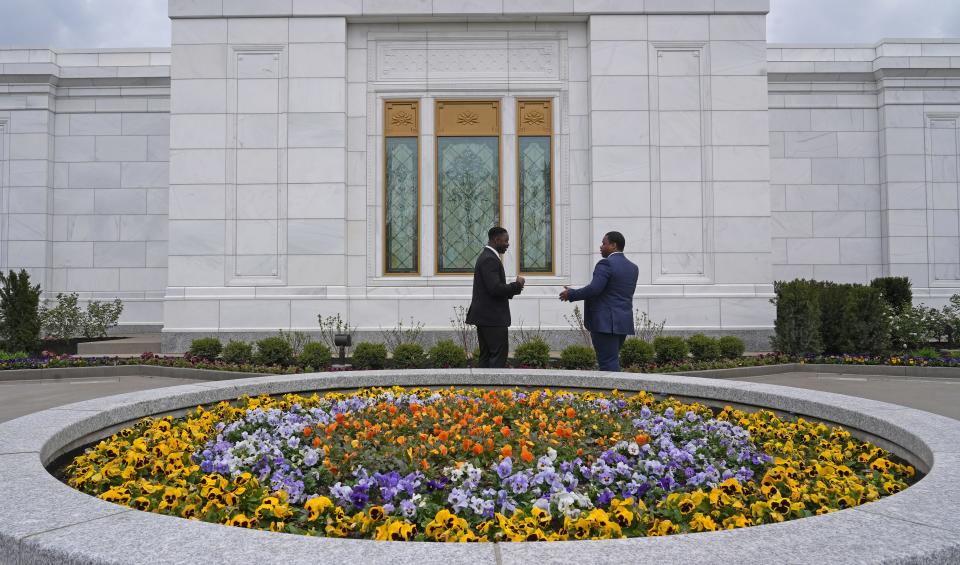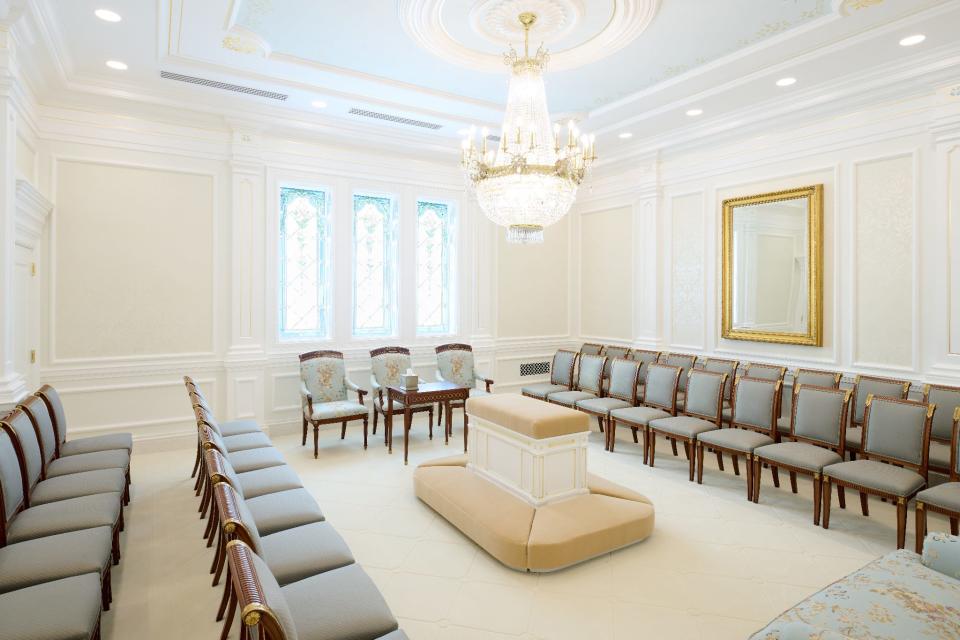Spirituality meets luxury in newly renovated Latter-day Saints' temple in Columbus
- Oops!Something went wrong.Please try again later.
Light pours through stained-glass windows into a room with immaculate white carpets and high cream walls, inlaid with gold and two large mirrors. A bouquet of magnolias sits atop a round table at the center of the space, below an ornate crystal chandelier, surrounded by lounge chairs. The room's brightness is surpassed only by its utter silence.
Is this heaven? Not quite.
Spirituality meets luxury in this, the “celestial room” at the Church of Jesus Christ of Latter-day Saints’ newly renovated temple in Columbus. Considered one of the most sacred spaces for church members, it is used for personal reflection and prayer.
“We call it the celestial room because to us, it really does depict what it might be to be in the presence of Heavenly Father,” said Kevin Duncan, executive director of the temple department for the church, which is based in Utah.
Although normally closed to non-church members, the space at 3870 Gateway Blvd. in the Golfview Woods neighborhood on Columbus' West Side is open for visitors between Saturday and May 13, before becoming restricted once again — possibly for decades to come. Visits can be booked online at: www.churchofjesuschrist.org/featured/columbus-ohio-open-house
The Church of Jesus Christ of Latter-day Saints is known for its emphasis on proselytization, but Kevin Birch, a Westerville-based area seventy, or church leader, said the open house is not necessarily about converting people.
“It’s not about spreading a religion or a faith. It’s about sharing what we know about heavenly Father … and we want to share that with any and all who want to come,” he told The Dispatch.
The Latter-day Saints used to call themselves Mormons, but in 2018 they changed their nomenclature.
There are more than 63,000 church members and nearly 130 congregations in Ohio, including approximately 25 congregations in the Columbus area, according to Sharon Rodger, a spokesperson for the Columbus North Stake (a local branch of the church).
Latter-day Saints’ temples differ from the chapels used for weekly services, and the one in Columbus is the only temple in Ohio.
Ohio featured in the church's early history
Joseph Smith founded the church in 1830 in upstate New York after receiving prophecies and translating the Book of Mormon from what he claimed was an ancient American Christian civilization.
Smith led his followers to Kirtland in Lake County, Ohio in 1831 before a banking crisis and persecution led them to relocate to Missouri and then Illinois, where Smith was murdered by a mob in 1844, according to Harvard University’s Pluralism Project. Under leader Brigham Young, members of the church migrated to Utah, which was governed as a theocracy until it joined the union as a state in 1896.
A temple still exists in Kirtland, but it is controlled by the Community of Christ, another group of Smith’s followers who split from the Church of Jesus Christ of Latter-day Saints in the 19th century.

Like all Latter-day Saints’ temples, the one in Columbus lacks crosses — a symbol that Smith disfavored. Although it covers nearly 12,000 square feet, it has no large hall. Instead, it is divided into smaller rooms designed for performing sacred rituals, called ordinances.
For example, one room contains a large marble pool, which is used for baptisms for the dead, in which church members are symbolically baptized in the name of their ancestors who never received the sacrament. The pool sits atop 12 life-size brass bulls that symbolize the 12 tribes of Israel, in a room adorned with oil paintings of John the Baptist and Jesus.
The baptisms for the dead are popular among teenagers, according to Duncan, the temple department director. Performing them involves extensive genealogical research, for which members often consult commercial websites and a church-run website.
Another ordinance room where church members receive videotaped teachings is painted with floor-to-ceiling murals of the Garden of Eden, which members believe was in North America. Wedding ceremonies, known as "sealings,” are performed in yet another room. Sealings are also performed in the name of ancestors to ensure that families stay unified in the afterlife, according to members' beliefs.
Although the church’s history is rooted in the U.S., where 85% of its members identify as white according to the Pew Research Center, it has been expanding rapidly through missionary work around the world. It claims to have over 17 million members worldwide, more than 10 million of whom live outside the U.S. About a third of its 177 temples are located abroad, according to Duncan.
Jeewarshav Adhikari, 20, a Columbus-based missionary member of the church who was born in Nepal, said he was awestruck when he first visited a temple in Utah at age 15.
“The thing I like most about the temple is everyone is treated equally — no one is more important than the others, no matter your wealth, your race or ethnicity,” he said.
Vai Sikahema, a Salt Lake City-based general authority seventy, or senior church leader, said there was no temple in the Pacific island nation of Tonga when he was growing up there. His parents farmed fruits and saved for years to afford a trip to the nearest temple, in Auckland, New Zealand, when he was a child. But in the years since, a temple was built in his homeland.
“One of the miracles in the church that’s happened in the last 40 years, and even the last 20 years, is we're building temples. We’re getting them closer to the people,” he said.

Peter Gill covers immigration, New American communities and religion for the Dispatch in partnership with Report for America. You can support work like his with a tax-deductible donation to Report for America at: bit.ly/3fNsGaZ.
pgill@dispatch.com
This article originally appeared on The Columbus Dispatch: Latter-day Saints' temple in Columbus now open to public

